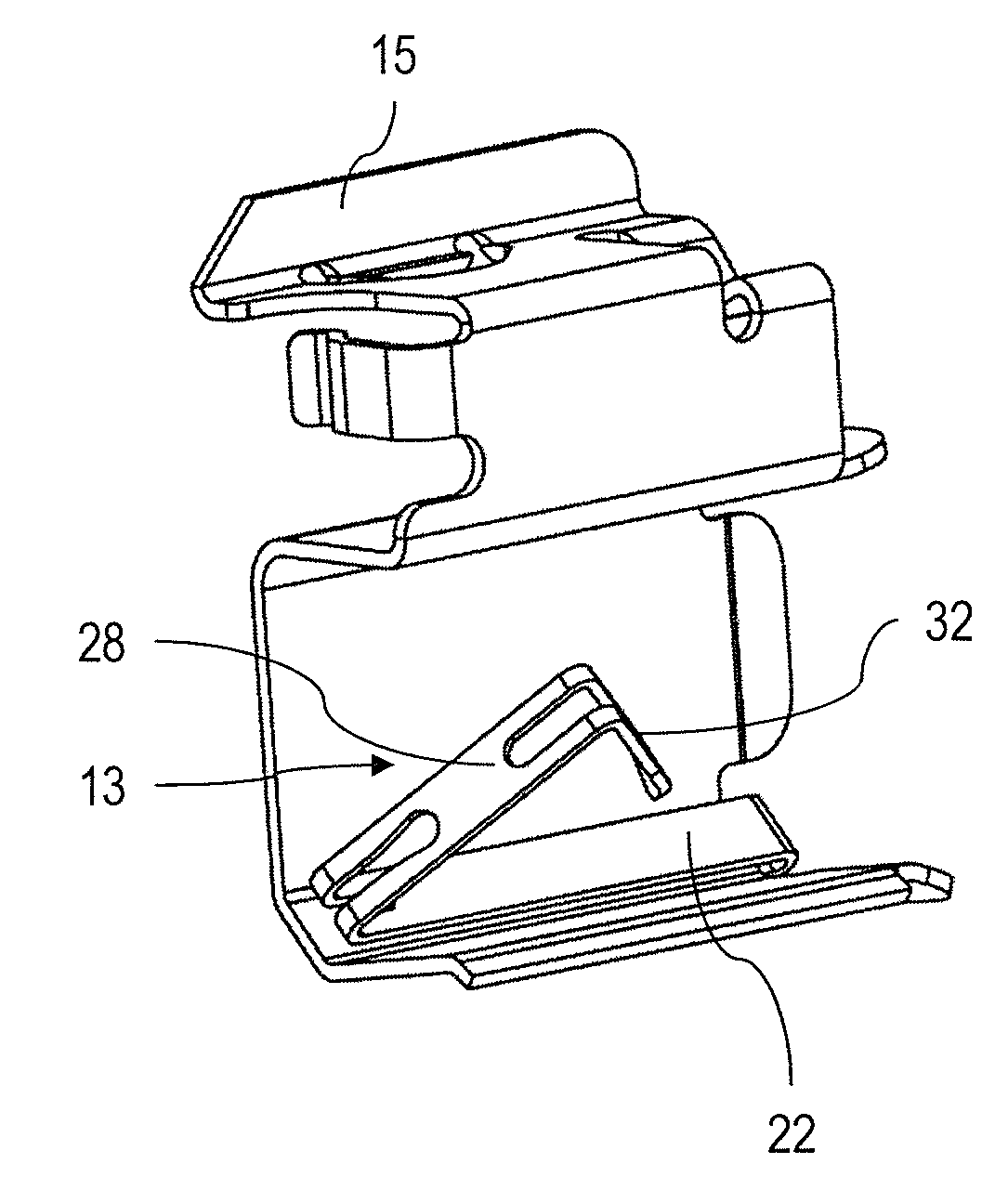Disc brake for a motor vehicle, comprising a plastically deformable restoring spring, and restoring spring
a technology of disc brake and restoring spring, which is applied in the direction of brake types, brake actuating mechanisms, slack adjusters, etc., can solve the problems of inability to predict whether the plastic deformation curve always corresponds precisely to the actual wear state, and the remaining elastic deformation component no longer provides an adequate restoring movement, so as to achieve reliable wear compensation and constant restoring behaviour
- Summary
- Abstract
- Description
- Claims
- Application Information
AI Technical Summary
Benefits of technology
Problems solved by technology
Method used
Image
Examples
first embodiment
[0032]During the service period of the disc brake 9 a brake lining, which is situated on parts of the surface of the brake lining arrangement 11 facing the restoring spring 13, is eroded by wear. In order that the response behaviour of the disc brake 9 remains constant, such wear is typically compensated by means of a wear correction corresponding to the actual brake lining wear. In this case the brake lining arrangement 11 is permanently displaced forward in the direction of the restoring spring 13 and / or in actuating direction. The starting position and / or restoring position of the brake lining arrangement 11 is likewise to be adapted by means of a wear correction to the increasing brake lining wear and / or to a compensating forward displacement of the brake lining arrangement 11. This means that the starting position and / or restoring position is likewise to be changed for the purpose of wear compensation. The restoring spring 13 according to the invention solves this problem of we...
second embodiment
[0042]In the second embodiment the restoring spring 13 and the guide clip 15 are manufactured by shaping from a common, initially flat component. This flat component is represented on its own in FIG. 10 and denoted by 40. It is evident that the restoring spring 13 and guide clip 15 initially take the form of substantially elongate portions 44 and 46 of the component 40. In this case the respective portions 44 and 46 already for the most part have the basic contours and recesses in accordance with the finished combination of restoring spring 13 and guide clip 15 shown in FIGS. 7 to 9. Thus, for example the previously described recesses 34 and 36 may be seen in the portion 44.
[0043]To manufacture the unit of restoring spring 13 and guide clip 15 according to the second embodiment the flat component 40 is bent around a plurality of bending axes, the position of which may be gathered from a combined viewing of the finished shaped component shown in FIGS. 7 to 9. It is self-evident that ...
third embodiment
[0046]The bending axis z, around which the surface area portion 44 is bent relative to the portion 46, extends in this embodiment at an angle α of 45° relative to the longitudinal axis L1 of the surface area portion 44. This enables the restoring spring 13 in the third embodiment also to be aligned in the same manner relative to the guide clip 15 and the actuating direction as in the examples discussed above.
[0047]A finished shaped unit according to the third embodiment is shown in FIGS. 12 and 13. Evident once more are the obliquely extending bending axis z and the portions of the restoring spring 13 that lie adjacent thereto. In order to increase the stiffness of the region bent around the bending axis z and avoid local concentrations of stress, the restoring spring in this region is configured with a curvature 48, which is likewise produced in the course of the shaping process.
[0048]In accordance with the provisions of the patent statutes, the principle and mode of operation of t...
PUM
 Login to View More
Login to View More Abstract
Description
Claims
Application Information
 Login to View More
Login to View More - R&D
- Intellectual Property
- Life Sciences
- Materials
- Tech Scout
- Unparalleled Data Quality
- Higher Quality Content
- 60% Fewer Hallucinations
Browse by: Latest US Patents, China's latest patents, Technical Efficacy Thesaurus, Application Domain, Technology Topic, Popular Technical Reports.
© 2025 PatSnap. All rights reserved.Legal|Privacy policy|Modern Slavery Act Transparency Statement|Sitemap|About US| Contact US: help@patsnap.com



